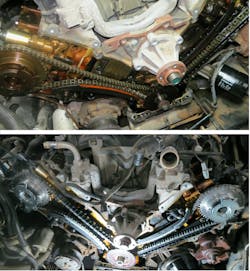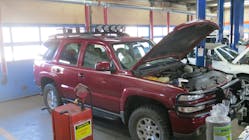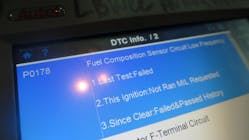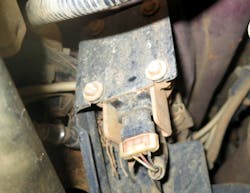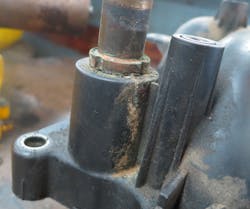I remember one period back in the mid-1990s when was seeing a lot of fuel pump failures. The vehicles would come in on the hook with no fuel pressure, and I’d check to see if the inertia switch was tripped. Then I’d toss a fuel pump in there, fire it up and test drive it, and all would be well. I was fully aware of the possible wiring concerns and whatnot, but I had seen so many fuel pump failures that I didn’t see the need to spend a lot of time data mining.
This one seemed to be a shade off, but not enough to account for the pattern we got, so it was time for exploratory surgery. With the valve covers and the timing cover off (no small feat), we discovered the real problem, which, it turns out, is more common than phasers. The straight fixed slide on the upper stretch of the No. 1 bank chain had disintegrated and that chain had been whipping around in there to make some pretty serious marks on the inside of the cover. This one would get a couple of phasers after all, along with new timing chains and all the stuff that goes with it. The guy I had doing the job was (and is) one of the most conscientious and careful second semester students I’ve ever seen, and I kept everybody out of his way while he plowed into that Navigator with one of the computers rolled over to where he was working. This B level job would have been a 14-hour flag for a line guy.
Those Crazy Others
Four more vehicles rolled in while the Navigator was under repair, a 1999 Town Car with a stubbornly steady number four misfire, a 2002 Taurus the owner said had an under-load bite at 45 mph (all too familiar), a 2004 Tahoe with an intermittent no-start problem and a 2001 F150 with electrical gremlins – the instrument cluster was remaining illuminated with the key off, complete with fluttering odometer segments and a dead battery after sitting overnight.
The Town Car’s No. 4 plug well was loaded with coolant, which led us to examine the heater hose fitting right above it. Sure enough that pressed-in hose pipe was leaking coolant into the spark plug cavity. That one got an intake manifold.
The Taurus wasn’t so cut and dried – the only concern the customer had voiced when I wrote that one up was the 45 mph irregular misfire bite, and he said he had already replaced the spark plugs and wires. The next morning, I fired it up to drive it into the service bay for preliminaries only to discover that it was surging dreadfully. It ran so bad it would barely pull off in any gear when it was cold. There was no need to go for a test drive – all this nonsense would need fixing before anything else was done.
Amber, one of my newer students, replaced the starter and then bench tested the old one. In spite of the fact that the old starter spun so well on the car, it would only click during the bench test. With the new starter in place, the long crank happened again, and I stabbed the EASE WVI’s green connector into the DLC (which is the quickest way to grab a code) and got the P0340 I expected. The cam sensor on bank number one would be our next move, but first we had to spray wash away about a pound of accumulated greasy crud from the sensor and its connector.
When the parts store arrived with the replacement sensor and it was installed, the Maxima fired up so fast the crank barely made a full round on starter power. With some battery terminal maintenance and a few more simple checks, the Maxima was done.
Tahoe Frontier Conquered
The owner of the Tahoe had called earlier that morning to suggest that I put it outside the shop for the night, which was going to be pretty chilly, and while I had her on the phone, I decided to start it up. All it would do was spin like the Maxima, but with no eventual start. She did say that when it pulled this stunt, you could leave it sitting for several hours and it would start and run just fine.
I poked around in Identifix and noticed that a couple of shops had run across problems like this that were caused by the Fuel Composition Sensor, but that sensor was still too expensive to take a chance on, so I opened a hotline call on it and got my verification from the GM guy. The P0178 was a strong indicator (56 hz notwithstanding) that the FCS was indeed the cause of this nonsense. I yanked a spark plug and found it very wet. Could the PCM be over-fueling the Tahoe thinking there was more alcohol in the tank than there actually was?
A call to the customer confirmed that her son, who drove the Tahoe never used E85 – he only pumped regular into that cavernous gas tank. We ordered the Fuel Composition Sensor when the owner green-lighted it and let the truck sit all night before installing the sensor. A follow up since has verified that the hard starting concern is fixed, albeit at a pretty stiff price.
I’ll be the first to say that, as an instructor, it’s kind of spooky to give a job this complicated to a second semester student. But I as I watched this guy carefully observing virtually everything the shop manual told him to do, I knew early on that this one would go well. And it did. While the job was under way, I told him that he would feel like Superman when he heard that 3-Valve fire up and run right.
My prediction was correct, but I must confess that, when I heard that Navigator light off, I felt as super as he did. We weren’t stunned by these phasers. We had breached our final frontier, at least for that week.


